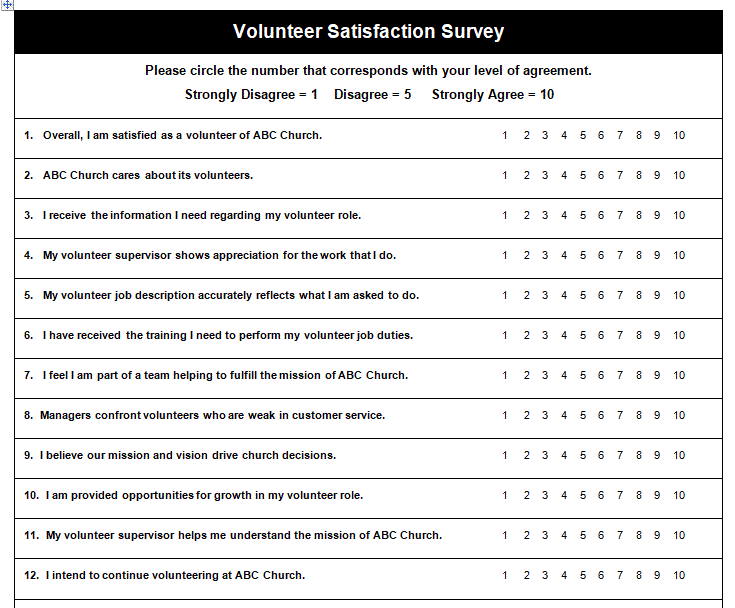Estimated reading time: 7 minutes
Successful organizations understand the value of listening to the feedback of their customers. In the non-profit world, one of the main customer groups is the volunteers.
Volunteers give their time and provide free labor because they care about the organization and have a passion for its vision and mission.
Keeping volunteers engaged ensures maintaining a long-term relationship. One way to engage them is to provide an opportunity for them to offer feedback about their experience.
This makes it important to create a system that facilitates two-way communication between the organization and its volunteers.
This two-way communication is a great way to improve how the organization does what it does by taking advantage of its volunteers’ collective experiences and perspectives.
Volunteers are often the front-line support and have experience delivering a service. They can often articulate what works and what could be improved in the operational process.
Create a Feedback Process
A structured feedback process can help your organization better understand the volunteer experience.
And what is learned from their feedback can be used to better support volunteers. This type of system is an important aspect of a volunteer program.
The feedback process should be structured so that there are predictable times when volunteers will be asked about their experiences.
This kind of structure ensures that issues are identified quickly and volunteers become comfortable sharing personal perspectives.
Volunteers can be the biggest advocates for the organization, and taking advantage of their perspective provides valuable information that can be used to improve the volunteer experience – as well as the services the organization provides.
Example Volunteer Satisfaction Survey

4 Opportunities to Solicit Volunteer Feedback
1. Baseline Feedback
If your organization has never solicited feedback from your volunteers, the first step should be to gather some baseline data by looking at volunteers’ global experience.
This is done to help identify any improvement opportunities that could be used to develop and enhance the volunteer program.
The beauty in asking for this kind of feedback is that the volunteers will willingly provide all the information needed to put together an improvement plan to help take the volunteer program to the next level.
The sample volunteer feedback form can determine where the organization is and monitor satisfaction as improvement initiatives are implemented.
This kind of feedback can also give you an idea about how the volunteer program supports the volunteers and what the program can do logistically to improve the volunteer experience.
For example, you may learn that volunteers do not receive their shift schedules on time, creating frustration with not knowing when they are scheduled to work.
Learning this type of information allows you to improve that experience for them.
2. Annual Surveys
As soon as the baseline data is gathered, it should be shared with leadership and put into action plans to address any suggestions or concerns.
Once the action plans are implemented, it is time to resurvey the volunteers and learn if the improvements addressed the volunteers’ issues.
Keep in mind that not every issue or concern that is raised will warrant correction.
When you open the door for feedback, some people take advantage of the process and solicit unrealistic requests.
A good rule of thumb is to ask, “Will addressing this concern help us to fulfill our mission better…?”
If the answer is yes, then do it. If the answer is no, do not.
One way to do this is to send the survey out monthly to smaller groups of volunteers so that you begin collecting monthly data.
This approach can help to identify issues every month rather than waiting for the annual survey.
To do this, take your volunteer database and sort it into 12 different groupings. The groupings can be alphabetical, by volunteer area, or just random.
Any way is fine as long as you keep track of who received a survey and when they received it, so you don’t accidentally send the same person a survey month after month.
3. After Special Events
Planning and facilitating big events requires a lot of work, great organization, and loads of logistical detail.
Volunteers who help with events always have a great perspective on what worked and what things could be improved.
They see things from two perspectives.
The first is their own experience as a volunteer.
Things like how well the communication process was, did the training prepare them well for their volunteer role; did they have everything they needed to perform their job tasks, etc.

The second perspective is how the needs of the people they served were met.
For example, if the volunteer worked at the summer vacation bible school, what did they learn from interacting with parents who dropped their children off?
If they heard the same complaints, then perhaps there is something broken in the process that needs to be fixed.
Volunteers are the first point of contact and hear direct responses, whether it be of gratitude or comments of dissatisfaction about something – volunteers get exposed to information that the organization needs to know.
Following up with volunteers after a big event can provide information that can be used to improve the event and the people it serves.
4. Small-Group Meetings
Sometimes, leaders host meetings with a smaller group of volunteers for special training, information sharing, or even event planning.
When these types of meetings take place, it is always good to solicit volunteer input.
Like employees, volunteers are closest to the processes and have a great perspective on improving operational efficiencies.
And it is in these intimate settings that structured conversation can lead to great insights.
Improvement Plans
Gathering all of this feedback is great, but unless the information is reviewed and incorporated into an improvement plan, it will merely gather dust on the shelf.
It is important to have the right leadership to review the information and work to develop a plan of action to address any issues or suggestions.
Putting together an improvement plan is basically like writing improvement goals.
The plan needs to answer the basic questions of who, what, how, and when.
Who will do what, how will it be done, and when is it due to be completed?
Example Volunteer Feedback Improvement Plan

Communicate Results
As with most things, closing the communication loop is very important.
It has little impact on the volunteers if they are not made aware of changes that result from their feedback.
There will always be suggestions or feedback that cannot be incorporated for a whole host of reasons.
However, make sure you take the time to inform the volunteers of the feedback received, what was done with the survey results, and the steps you’ve taken to make applicable improvements.
This communicates to the volunteers that you followed through on your commitment to take action on their feedback, and it sends the message that you value their input.
This is another example of things that organizations can do to strengthen the relationship, volunteer engagement, and commitment of their volunteers.
Do you solicit feedback from your volunteers?
If you are a member of SCM, you can login to your account here to access editable copies of these documents.
If you are not a member and would like access to editable copies of these documents, you can learn more here.



